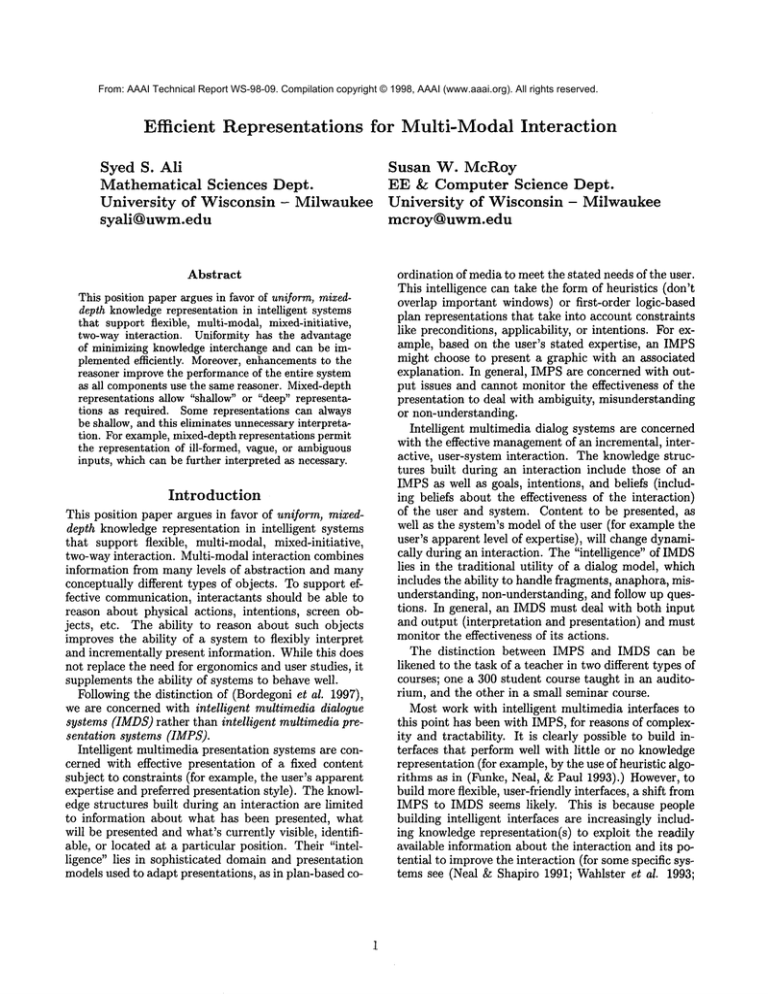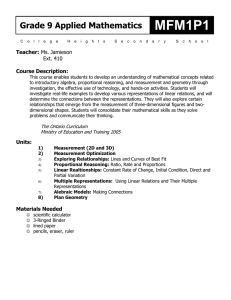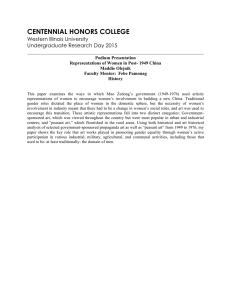
From: AAAI Technical Report WS-98-09. Compilation copyright © 1998, AAAI (www.aaai.org). All rights reserved.
Efficient
Representations
Syed S. All
Mathematical Sciences Dept.
University of Wisconsin - Milwaukee
syali@uwm.edu
Abstract
This position paper argues in favor of uniform, mixeddepth knowledgerepresentation in intelligent systems
that support flexible, multi-modal, mixed-initiative,
two-way interaction. Uniformity has the advantage
of minimizing knowledgeinterchange and can be implemented efficiently. Moreover,enhancementsto the
reasoner improvethe performanceof the entire system
as all componentsuse the same reasoner. Mixed-depth
representations allow "shallow" or "deep" representations as required. Somerepresentations can always
be shallow, and this eliminates unnecessaryinterpretation. For example, mixed-depthrepresentations permit
the representation of ill-formed, vague, or ambiguous
inputs, whichcan be further interpreted as necessary.
Introduction
This position paper argues in favor of uniform, mixeddepth knowledge representation in intelligent systems
that support flexible, multi-modal, mixed-initiative,
two-way interaction. Multi-modal interaction combines
information from many levels of abstraction and many
conceptually different types of objects. To support effective communication, interactants should be able to
reason about physical actions, intentions, screen objects, etc. The ability to reason about such objects
improves the ability of a system to flexibly interpret
and incrementally present information. While this does
not replace the need for ergonomics and user studies, it
supplements the ability of systems to behave well.
Following the distinction of (Bordegoni et al. 1997),
we are concerned with intelligent multimedia dialogue
systems (IMDS) rather than intelligent multimedia presentation systems (IMPS).
Intelligent multimedia presentation systems are concerned with effective presentation of a fixed content
subject to constraints (for example, the user’s apparent
expertise and preferred presentation style). The knowledge structures built during an interaction are limited
to information about what has been presented, what
will be presented and what’s currently visible, identifiable, or located at a particular position. Their "intelligence" lies in sophisticated domain and presentation
models used to adapt presentations, as in plan-based co-
for Multi-Modal Interaction
Susan W. McRoy
EE &: Computer Science Dept.
University of Wisconsin - Milwaukee
mcroy~uwm.edu
ordination of media to meet the stated needs of the user.
This intelligence can take the form of heuristics (don’t
overlap important windows) or first-order logic-based
plan representations that take into account constraints
like preconditions, applicability, or intentions. For example, based on the user’s stated expertise, an IMPS
might choose to present a graphic with an associated
explanation. In general, IMPSare concerned with output issues and cannot monitor the effectiveness of the
presentation to deal with ambiguity, misunderstanding
or non-understanding.
Intelligent multimedia dialog systems are concerned
with the effective managementof an incremental, interactive, user-system interaction. The knowledge structures built during an interaction include those of an
IMPSas well as goals, intentions, and beliefs (including beliefs about the effectiveness of the interaction)
of the user and system. Content to be presented, as
well as the system’s model of the user (for examplethe
user’s apparent level of expertise), will change dynamically during an interaction. The "intelligence" of IMDS
lies in the traditional utility of a dialog model, which
includes the ability to handle fragments, anaphora, misunderstanding, non-understanding, and follow up questions. In general, an IMDSmust deal with both input
and output (interpretation and presentation) and must
monitor the effectiveness of its actions.
The distinction
between IMPS and IMDS can be
likened to the task of a teacher in two different types of
courses; one a 300 student course taught in an auditorium, and the other in a small seminar course.
Most work with intelligent multimedia interfaces to
this point has been with IMPS,for reasons of complexity and tractability. It is clearly possible to build interfaces that perform well with little or no knowledge
representation (for example, by the use of heuristic algorithms as in (Funke, Neai, & Paul 1993).) However,
build more flexible, user-friendly interfaces, a shift from
IMPS to IMDSseems likely. This is because people
building intelligent interfaces are increasingly including knowledgerepresentation(s) to exploit the readily
available information about the interaction and its potential to improvethe interaction (for somespecific systems see (Neal & Shapiro 1991; Wahlster et al. 1993;
Traum et al. 1996); an architecture for IMPSthat explicitly promotes knowledge "experts" is that of (Bordegoni et al. 1997)). In this paper we are going
argue that an IMDSshould use a knowledge representation with specific characteristics: it must be uni]orm
and allow mixed-depth representations. These characteristics help address the complexity and tractability
problems in building detailed models of dialog.
Weterm a knowledge representation uniform when it
allows the representation of different kinds of knowledge
in the same knowledge base using the same inference
processes. For example, the representation of a spoken
Huh might be represented similarly to a typed Huh? and
reasoned with identically. (Minimally, modality information would differ in the representations; this could
be used to track the user’s preferred modality.)
A mixed-depth representation is one that maybe shallow or deep in different places, depending on what was
known or needed at the time the representation was
created (Hirst & Ryan 1992). Moreover, "shallow" and
"deep" are a matter of degree. Shallow representations
might be a representation of the interaction such as a
sequence of time-stamped events. Deep representations
might be a conventional first-order (or higher-order)
knowledge representation. Unlike quasi-logical form,
which is used primarily for storage of information,
mixed-depth representations are well-formed propositions, subject to logical inference. Disambiguation and
interpretation,
when it occurs, is done by reasoning.
Most KRsystems allow mixed-depth representations,
uniform KRsystems require them (because everything
is represented in the same knowledge base).
To motivate our argument for uniform, mixed-depth
representation we first argue the advantages of such representations in an ongoing interaction; we then discuss
the practicable nature of the proposed representations.
The Advantages of Uniform
Representations
The primary advantage of a uniform representation
is that it eliminates knowledge interchange overhead.
That is, there are no special-purpose reasoners with specialized knowledgerepresentation(s), and all reasoning
uses the same reasoner. Webelieve that this may scale
better than the traditional non-uniform approach. We
are not alone in advocating a uniform representation,
see for example Soar (Rosenbloom, Laird, & Newell
1993).
The traditional approach to building intelligent, interactive systems is to "compartmentalize" the specialpurpose reasoners with different knowledgerepresentations appropriate to the specialized tasks. This is efficient in the initial stages of system building, however
as a system matures, components with rich, detailed
representations will have to communicate with components having more superficial representations. Knowledge interchange is a serious problem, even in systems
that have a commonknowledge representation ancestor,
such as KL-ONE(Heinsohn et al. 1994). One common
problem that arises is conflicting ontologies (Traum
et al. 1996). For example the TRAINS-93 system
has many special-purpose components where each component has its own fairly sophisticated representation
(Logical Form, Episodic Logic, Conversation Representation Theory, Tyro, Event-based Temporal Logic). In
later work with the TRAINS-96
system there is still the
stratified architecture, however the componentsall have
more superficial representations, and communicatewith
each other in KQML
(Ferguson et al. 1996).
Uniform representations have not been used in traditional intelligent interfaces for reasons of perceived computational and management complexity. In industry,
project managementis achieved by the use of standards
and standards committees that enforce the goal of uniformity. Thus, we feel that managementcomplexity is
tractable. Computational complexity is more problematic, as the speed of inference in a monolithic knowledge
base has been shownto grow in proportion to the knowledge (Heinsohn et al. 1994). There are two answers to
this--the first solution is to use distributed computation for reasoning and knowledge base access (Geller
1994). The second is to structure the knowledgefor efficient access. This is done by adding meta-knowledge
that specifies the nature of the knowledgein the uniform knowledge base. For example, knowledge associated with the current user model would be indexed by
meta-facts (that say that these are facts about the user
model). Using these meta-facts to index the knowledge base, reasoning about the user model can be done
without search. In our current work with B2, a collaborative system that allows medical students to practice
their decision-making skills, we have a single knowledge
representation and reasoning component that acts as a
blackboard for intertask communication and cooperation (McRoy,Haller, & Ali 1997). All knowledgeis represented using a semantic network formalism (Shapiro
& Rapaport 1992). Westructure the knowledge by the
"links" between facts in the knowledgebase. Thus, for
example, all knowledgeabout, or references to the concept "disease" share the same subnetwork corresponding to that concept. This uniformity allows a concept
to be realized as a presentation in multiple ways, depending on the context. The concept "disease" could
be realized as a unpleasant graphic, a textual word,
or a spoken word, but all realizations would share the
commonunderlying concept.
The Advantages of Mixed-Depth
Representations
To maintain a complete model of the interaction, the
interaction model must have multiple levels of information, corresponding to different levels of abstraction.
Minimally these levels are analogous to the locutionary/illocutionary
distinction made by Austin (Austin
1962). Figure 1 gives some simple examples (a planbased approach using these kinds of communicative acts
Modality
Text
Locution
Words
Mouse
click(x,y, type), mode(t)
Graphic
barchart
Illocution
Questions, Answers, Requests,
such as Why?, Tell me a story.
Command(operation (mode(t),
click(type),
object-at(x,y))
such as Selecttopicof gallstones
Comparerelative magnitudes of probabilities
Figure 1: Example locutions and corresponding illocutions
for multimedia can be found in (Maybury 1993).)
The difficulty with requiring "deep" knowledgerepresentations (i. e., completely interpreted), is that much
of an ongoing interaction maybe uninterpretable at the
momentit occurs, or it maybe subject to multiple interpretations or misinterpretation. Mixed-depth representations are more efficient than "deep" representations
because computation can be postponed until needed (if
ever). Additionally, such representations better tolerate lack of information or ill-formed inputs (minimally
because a representation of only the locution is built).
In our current work, the mixed-depth approach allows us to use the same representation framework to
produce a detailed representation of requests (which
are often interpreted through plan recognition without
considering the context) and to produce a partial representation of questions (which tend to require more inference). Moreover, these representations use the same
knowledgerepresentation frameworkthat is used by the
system to reason about the discourse and the domain-so that the system can reason with (and about) the
utterances, if necessary.
Summary
We have argued for uniform, mixed-depth knowledge
representation in intelligent systems that support flexible, multi-modal, mixed-initiative, two-wayinteraction.
Uniformity has the advantage of minimizing knowledge
interchange and can be implemented efficiently. Moreover, enhancements to the reasoner improve the performance of the entire system as all components use
the same reasoner. Mixed-depth representations allow
"shallow" or "deep" representations as required. Some
representations can always be shallow, and this eliminates unnecessary interpretation.
For example, mixeddepth representations permit the representation of illformed, vague, or ambiguous inputs, which can be further interpreted as necessary.
References
Austin, J. L. 1962. Howto Do Things with Words.
London, England: Oxford University Press. Reprinted
1975.
Bordegoni, M.; G.Faconti; Maybury, M. T.; Rist, T.;
Ruggieri, S.; Trahanias, P.; and Wilson, M. 1997.
A standard reference model for intelligent multimedia
presentation systems. In Proceedings of the IJCAI ’97
Workshop on Intelligent Multimodal Systems.
Ferguson, G. M.; Allen, J. F.; Miller, B. W.; and Ringger, E. K. 1996. The design and implementation of the
trains-96 system: A prototype mixed-initiative planning assistant.
TRAINSTN 96-5, Computer Science
Dept., University of Rochester.
Funke, D. J.; Neal, J. G.; and Paul, R. D. 1993. An
approach to intelligent
automated window management. International Journal of Man-MachineStudies
38:949-983.
Geller, J. 1994. Advanced update operations in massively parallel knowledge representation. In Kitano,
H., and Hendler, J., eds., Massively Parallel Artificial
Intelligence. MITPress. 74-101.
Heinsohn, J.; Kudenko, D.; Nebel, B.; and Profitlich,
H.-J. 1994. An empirical analysis of terminological
representation systems. Artificial Intelligence 68:367397.
Hirst, G., and Ryan, M. 1992. Mixed-depth representations for natural language text. In Jacobs,
P., ed., Text-Based Intelligent Systems. LawrenceErlbaum Associates.
Maybury, M. T. 1993. Planning multimedia explanations using communicative acts. In Maybury, M. T.,
ed., Intelligent
Multimedia Interfaces.
AAAI/MIT
Press. 59-74.
McRoy, S.; Haller, S.; and Ali, S. 1997. Uniform
knowledge representation for nlp in the b2 system.
Journal of Natural LanguageEngineering 3(2).
Neal, J. G., and Shapiro, S. C. 1991. Intelligent multimedia interface technology. In Sullivan, J. W., and
Tyler, S. W., eds., Intelligent User Interfaces. New
York: ACMPress. 11-44.
Rosenbloom,P.; Laird, J.; and Newell, A., eds. 1993.
The Soar Papers: Readings on Integrated Intelligence.
MIT Press.
Shapiro, S. C., and Rapaport, W. J. 1992. The SNePS
family. Computers 8~ Mathematics with Applications
23(2-5).
Traum, D. R.; Schubert, L. K.; Poesio, M.; Martin,
N. G.; Light, M. N.; Hwang, C. H.; Heeman, P. A.;
Ferguson, G. M.; and Alien, J. F. 1996. Knowledge
representation in the trains-93 conversation system.
International Journal of Expert Systems 9(1):173-223.
Wahlster, W.; Andre, E.; Finkler, W.; Profitlich, H.J.; and Rist, T. 1993. Plan-based integration of natural language and graphics generation. Artificial Intelligence 63:387-427.






